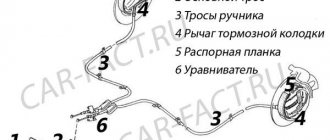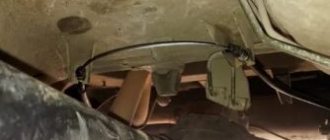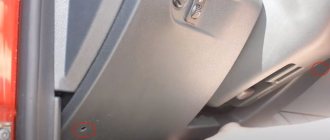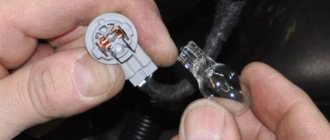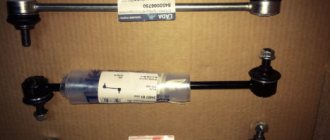Adjusting the parking brake on Vesta. Plan b
As we said above, now our task is to figure out the mechanism for automatically lining the pads with little effort, without removing the brake drums. And this is quite possible. To manually adjust the pads and make the handbrake work normally, proceed as follows:
- We hang the rear wheels, having previously removed the mounting bolts.
- We remove the wheels.
- Install the hole for the bolt with right side by about 11 o'clock , and with left on 13 hours .
From the left side - Using a well-tucked flat-head screwdriver, rotate the gap adjuster between the pads and the drum through the hole. down up , counterclock-wise. Not entirely convenient, but quite possible if you illuminate it with a flashlight.
- Rotate the auto liner adjusting nut until the drum lightly touches the pads.
- We do the same on the right side , but here you need to rotate top down .
On the right side
The handbrake lever must be lowered completely.
We attach the wheels and check the operation of the handbrake. If necessary, tighten the cable as described using standard technology, using an adjusting nut from the interior. As a result, we get excellent performance of the rear brake mechanisms and an iron handbrake that confidently holds on the second or third click.
Lada Vesta handbrake adjustment
We replace the pads of a Lada Vesta car in case of maximum permissible wear of their linings or the brake drum of the rear wheel.
LADA > Vesta
The pads also need to be replaced if the linings are oily, have deep grooves and chips on them, or if the linings are detached from the base of the pads. We carry out the work on a flat area, inspection ditch or overpass.
Attention!
The brake pads of the rear wheels must be replaced as a set - all four pads. Replacing the pads of only one brake mechanism can lead to the car pulling to the side when braking.
We show replacing the pads on the right rear wheel. Before removing the brake drum, lower the parking cable lever all the way - the car must be released.
We remove the rear wheel and securely fix the car on a factory-made support stand.
To remove the drum, the pads must be brought together.
The nature of the malfunctions can be noted:
- Uniform wear - it manifests itself in the fact that the friction layer is worn evenly, this shows that the brakes are working well.
- Severe wear of the friction layer, brake rivets are visible - this means that you have been using the “outdated” parts for too long. The rivets could damage the disc, so it would be a good idea to inspect it for damage.
- The friction layer is worn evenly around the entire circle, but one of the sides is worn out more than the other - one of the parts of the brake system (guide or piston) does not distribute the braking force correctly. Cleaning all “live” parts and applying a new layer of lubricant will help. Naturally, everything will have to change.
- Both components are worn unevenly, the surface is strewn with irregularities and roughness. The reason for this outcome is a malfunction of the caliper guide pins - they swing and do not give an even trajectory of movement. You will have to clean them, then reapply lubricant.
- The friction lining is cracked - in this case, the “trouble” is caused by the brake discs themselves - they wear unevenly. Everything will have to change.
- Uneven wear of the friction layer means that the parts were installed incorrectly. They will have to be changed.
New Lada: New Lada Vesta in Odintsovo After performing a visual inspection of the damage, you can independently make a verdict about the breakdown. And besides this, there are several other signs by which you can find out about a faulty front pad while sitting behind the wheel.
DSC_9261 (Copy)
After installing the brake drum, tighten the hub bearing nut to the prescribed torque of 175 N∙m.
It is advisable to install a new self-locking nut. On the left wheel this requirement is more critical than on the right.
Similarly, we replace the brake pads of the right wheel.
We check the brake fluid level in the hydraulic drive system reservoir and, if necessary, bring it to normal.
To adjust the position of the brake pads, press the brake pedal several times. We hold it down and then raise and lower the parking brake (when moving the lever, you must keep the parking brake release button on the lever depressed at all times so that the ratchet mechanism does not work). In this case, clicks will be heard in the brake mechanisms of the rear wheels from the operation of the mechanism for automatically adjusting the gaps between the pads and brake drums. We raise and lower the parking brake lever until the clicking in the brake mechanisms stops.
If necessary, adjust the parking brake.
Signs of Worn Pads
Problems in the operation of brake linings can arise as a result of natural abrasion or poor-quality material of the product, leading to rapid wear of the surface of the vehicle pad.
What you should pay attention to in order to prevent the ineffective operation of brake linings in time:
The appearance of a large lift of the parking brake handle. Normal lifting of the Lada Vesta is determined by 3 or 4 clicks. Another indicator is that on an incline, with the handbrake raised, the car begins to roll downhill. Of course, this could be due to a stretched cable.
- On Vesta with increased comfort, electronic sensors are installed that signal a critical level of pad wear.
- A sharp decrease in brake fluid level.
- The brake pedal begins to gradually sink.
- When braking, the car skids to one side.
- During the operation of the vehicle, the braking distance begins to change upward.
Since the Lada Vesta has become more advanced during the design process, its braking system includes automatic adjustment of the handbrake, which will be effective regardless of the gearbox used - manual or automatic; pronounced signs of pad wear practically do not show themselves. In some cases, the car may experience uneven braking and a slow response to the brake pedal, but this does not necessarily indicate wear on the linings.
According to information from service specialists, on average, the linings on a Lada car will last 30-45 thousand. Compared to one of the first VAZ 2105s, this is quite a lot.
Adjusting the parking brake Lada Vesta
The parking brake should hold the vehicle on a 23% grade. The full stroke of the parking brake drive lever should be 7-13 teeth (clicks) of the lever sector ratchet device. We hang up the rear wheels. Fully lower the parking brake lever.
Holding the end of the cable with pliers, use a 13mm wrench to turn the adjusting nut clockwise, tensioning the cables until the rear wheels become difficult to turn.
After this, unscrew the nut until the rear wheels begin to rotate freely.
It is convenient to adjust the tension of the cable with a high head with a ratchet and an extension. In this case, we do not completely unscrew the locknut, but, having aligned its edges with the edges of the adjusting nut, we put the high head on “13” and rotate both nuts at once.
We check the adjustment of the parking brake - when the lever travels 7-9 teeth of the ratchet device at full travel, the rear wheels should not rotate, and when the lever is lowered, the suspended wheels should rotate freely. We fix it with a locknut
adjusting nut. If necessary, repeat the adjustment. If it is impossible to adjust the parking brake, you need to check the condition of the brake mechanisms of the rear wheels and, if necessary, replace the shoes, drums and parking brake cables.
Video on the topic “Lada Vesta. Adjusting the parking brake"
tightening the handbrake of the Lada Vesta HOW TO PULL THE HANDBRAKE CABLE ON THE LADA VESTA IN 2 MINUTES FROM THE INTERIOR IN 2 MINUTES #Lada Vesta. Let's hype together. What happened to the handbrake? Mileage 15000
The hand brake, or as it is also called the parking brake, performs an important function. It holds the car in place when the owner needs it. Loosening the handbrake can lead to unpleasant consequences, after which you will have to repair your car, and possibly someone else’s. That is why it is important to monitor the condition of the handbrake and adjust it if necessary.
Design features
The adjustment instructions are meaningless if you are not familiar with the parking brake.
Often, when self-adjusting, we are talking about units that are based on a cable and a mechanical drive. With an electronic handbrake, it is better to seek help from a car service center.
The classic handbrake is found on a variety of cars, including:
- Lada Granta;
- Gazelle;
- Opel Zafira;
- Lada Kalina;
- Renault Logan;
- Lada Vesta;
- Chevrolet Lacetti;
- Renault Duster;
- VAZ 2110;
- VAZ 2107;
- Opel Vectra, etc.
Each automaker uses its own components to create the unit responsible for the handbrake.
At the same time, the structural elements are approximately the same everywhere. This allows the suspension a certain line under the bulk of vehicles in the matter of adjusting the handbrake.
As for these same design elements of the parking brake, I would like to highlight 3 main components.
- Lever arm. Serves to turn the handbrake on and off. Located in the vehicle interior, usually in close proximity to the driver, under the right arm;
- Adjustment unit. It includes rods, an equalizer, a fixing and adjusting nut, as well as a rubber boot;
- Drive cable. This is a steel cable located inside a flexible twisted winding. Connects the adjusting unit and the rear brakes on the car.
The rear wheels also contain some braking elements to ensure that the parking handbrake is functional.
How to tighten the handbrake on a Lada Kalina
To tighten and adjust the handbrake, everything is simple. From the toolkit you will only need one 10mm wrench and two 13mm wrenches. Since the adjusting mechanism is protected and bolted, a tool that may come in handy is WD-40 . You will have to tighten the handbrake after replacing the rear brake pads.
So, let's consider the sequence of actions:
- Using a 10mm wrench, it is better to use a head with a ratchet, unscrew the protection. Since it is constantly exposed to the environment (water, dirt, snow), the bolt could rust. This is where WD-40 is needed.
- Using a 13mm wrench, unscrew the outer cable adjustment nut several turns.
- Turn the inner nut clockwise to tighten the cable.
- When everything is done, we fix it with the outer nut by tightening it to the inner one.
- Let's put everything back together.
Thus, the cable is tightened and the handbrake is adjusted.
Replacing the handbrake cable
There are times when the cable has sagged so much that there is no point in adjusting it. In this case, it is necessary to replace it.
The process is quite simple and can be done with your own hands. Let's look at how this is done step by step:
- We drive onto a pit, lift or overpass.
- Remove both rear wheels.
- Unscrew the nuts securing the cables from the beam.
- Remove the brake drum covers.
- We remove the cables from the brake pad mounts.
- Unscrew the cable tensioner nuts.
- We dismantle the cables.
- Now we put the cables into the drums and connect them to the tensioner.
- We adjust the hand brake.
- Let's put everything back together.
Thus, it can be seen that replacing the cable is quite easy and simple.
Why do we need a working handbrake?
A hand brake is an element of the vehicle’s braking system, which performs the function of blocking the wheels relative to the axis of movement of the vehicle, and thus ensures the stability of the vehicle on the moving surface (including on a sloped surface).
A working handbrake performs the following functions:
1. Provides vehicle stability on the road surface when parked or on slopes.
2. Helps with emergency braking.
3. If you have the skills, you can use it to enter a controlled drift.
4. If the foot brake breaks down, it can perform its functions.
But it is worth noting that it is impossible to use the handbrake as a permanent braking element (instead of a foot brake), because its main purpose is to secure the car while parking. If you need to use the handbrake when braking while driving, it is not recommended to pull it sharply, as this will cause the car to skid.
The design and principle of operation of the hand brake are quite simple. It consists of three main components:
1. Mechanical drive.
2. Actuator.
3. Control node.
The mechanical drive is made in the form of a hand brake cable. This cable acts on the rear brake pads or on the transmission (depending on the design features of the car). The rocker arm installed in the handbrake ensures uniform cable tension on the two brake pads.
The actuator of the handbrake is the brake pads of the rear axle, which can be driven not only from the handbrake lever, but also from the foot brake pedal. This was done for simplicity of design and for easier vehicle maintenance.
The handbrake is activated by a control unit, represented by a handbrake lever with a ratchet, which controls the tension of the cable. It is located between the driver's seat and the passenger's seat in the central tunnel. On cars with an automatic transmission, there is a foot pedal for the parking brake instead of a lever.
The activation of the handbrake is indicated by a sensor in the form of a light bulb on the dashboard. This sensor helps the driver navigate when the handbrake is on and remember to remove the car from the handbrake before starting to drive. In some cars, if you drive with the handbrake on, a beep will sound, which is very convenient, because drivers often forget to turn off the handbrake.
The process of adjusting the handbrake on Lada Vesta cars
The process of tightening the handbrake consists of tightening/loosening the adjusting nut. Many car enthusiasts, when adjusting the handbrake, rely on the clicks that the handbrake makes when the handle is lifted. But this technique is not entirely correct, because on different cars, complete wheel locking can be achieved with a completely different number of handbrake clicks. However, using this popular technique, you can trace the changes made to the operation of the handbrake when adjusting the nut.
Removing, adjusting and installing the Lada Largus manual brake lever
Tools:
- Electrohydraulic lift type P-3.2G
- Medium flat screwdriver
- Driver for socket attachment
- Extension for the end attachment on the wrench
- Torx wrench attachment T-20
- 10mm wrench attachment
- 13mm wrench attachment
- Torque wrench
- 10mm curved box spanner
- Calipers
- Wheel key
Removal
1. Place the vehicle in the work station, apply the parking brake and turn off the ignition.
2. Remove the floor tunnel lining by unscrewing the screws that secure it using a socket wrench and a screwdriver.
3. Move the boot under the handbrake lever and loosen the adjusting nut of the handbrake lever equalizer cable using a socket wrench.
4. Disconnect both cables from the equalizer.
5. Remove the two nuts securing the arm to the floor tunnel studs using a socket wrench.
6. Then disconnect the wiring harness connector 1 from the handbrake lever warning light switch.
Handbrake warning switch:
1 — block of the instrument panel wiring harness.
7. Remove the handbrake lever.
Installation
1. Connect the wiring harness block to the warning light switch of the manual brake lever, install the lever on the mounting studs and secure with two nuts using a socket wrench. Ensure the tightening torque of the nuts is 8 N·m (0.8 kgf·m) using a torque wrench.
2. Install the handbrake cables into the equalizer holes.
3. Screw the adjusting nut of the manual drive lever so that dimension X from the upper end of the adjusting nut to the end of the threaded part of the equalizer cable is 16 ± 0.3 mm.
Hand brake parts:
1 - manual brake lever;
2 — equalizer cable for the manual brake lever;
3 — adjusting nut of the equalizer cable;
4 — equalizer for manual brake cables;
5 — manual brake cables;
X is the adjustment dimension for tensioning the cables, X = 16 ± 0.3 mm.
Adjusting the hand brake
1. Place the vehicle on a two-post lift, apply the parking brake, and turn off the ignition.
2. Tighten and release the manual brake lever five times to the original position to bring the drive cables into working condition.
3. Make sure the rear wheels rotate. If not, check the following items and repair or replace them as necessary:
Handbrake tightening - instructions
On the Lada Vesta, adjusting the handbrake is much more convenient than previously in older AvtoVAZ models - now this can be done while sitting inside the car in the driver's seat. According to the manufacturer's regulations, the tightening should be done every 30,000 km, or better yet, a little earlier.
- Raise the rear of the car so that you can manually turn the rear wheels. Fully lift and release the handbrake lever several times - this will bring the mechanism into working condition. Fully tighten the handbrake.
- Remove the plastic plug under the brake lever. Lift the rubber plug and you will see a nut on the end of the handbrake.
- Using a number 10 wrench, loosen the nut slightly and move the lever to about the second tooth.
- Tighten the nut until the rear wheels are firmly seated and cannot be turned by hand.
- Raise and lower the lever several times.
3 years and 5 months ago / Secrets
Specialists from the VAZ plant claim that on a Lada Vesta car it is necessary to tighten the handbrake cable every thirty thousand kilometers. If the handbrake does not hold the car before the specified mileage, then repairs must be carried out immediately. In addition, in the new Lada Vesta you can adjust the cable directly from inside the car, while in previous Lada models the adjustment was performed under the car.
adjustment + photo and video
Incorrect operation of the handbrake can cause an accident or some other serious incident.
Introduction
For example, even with the simplest job of replacing a broken tire, you must put the car on the handbrake, otherwise you risk “putting” the car on the bumper as a result of the car “driving” forward. And this is not the worst thing that can happen! You may cause yourself serious physical harm.
Toyota BB was dropped on the asphalt
The same Toyota
Classic fell off the jack
A necessary tool for tightening the handbrake.
Head 8 for ratchet
Set of keys for 13
Partner (preferably the coolest car mechanic)
- Two keys for 13. It is advisable that one of them be a socket.
- Head 8.
- A partner, but you can do without him. The truth is it’s more difficult without him.

